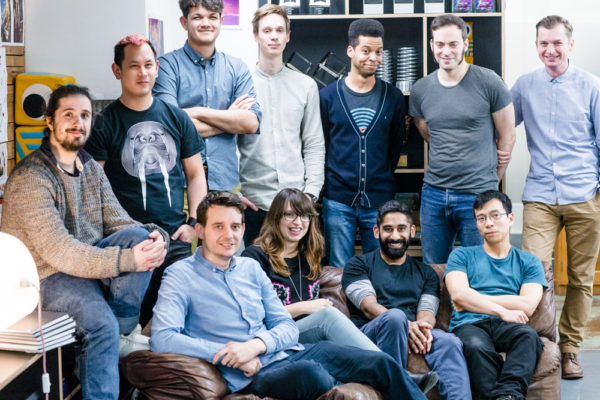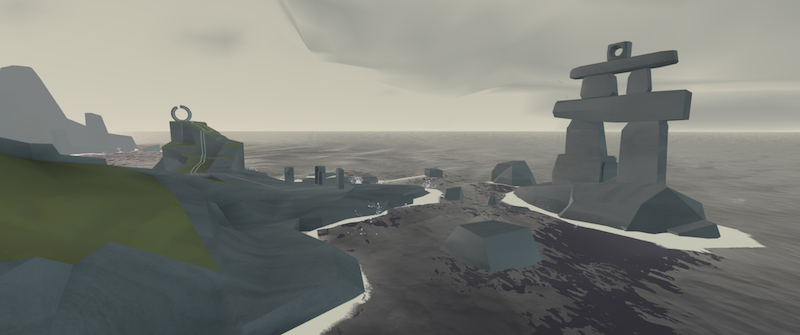Land’s End: the best VR game ever created?
It’s seen in the gaming sector as a game changer – literally. Created by digital product and service studio ustwo, Land’s End has been cited as “one of the best VR games so far” by the gaming website Polygon and “a relaxing, almost purifying experience” by the technology news platform Engadget. Wired magazine waxed lyrical about its charms, saying “If you could live in a sunset, this may be what it feels like”.
Strange to realise that this ground-breaking experience might never have happened – if it wasn’t for the tenacity of the team that built it. “We were approached by Oculus to create the game for the Samsung phone when they wanted to bring VR to the mass market,” explains one of the game’s producers, Michael Anderson. This was a huge step change as it moved VR out of the realm of powerful and very expensive computers and into the pockets of anyone with a Samsung smart phone and inexpensive headset. Of course, as with anything that is truly game changing, this brought its own challenges.
Making an industry first
Because this was a first, the team had nothing to draw on. There was no roadmap for building a VR experience for a phone. To describe it as a challenge would be the understatement of the year.
“Yes, it definitely was a challenge,” Michael agrees. “We had nothing to compare it against and no examples to take from the industry. Even something as simple as getting the scale right took us a lot of experimentation. We ended up taking the chairs from our office to re-create in a virtual reality environment to get the size right.”
Being contracted to remain silent about the project also meant they couldn’t discuss it outside the company. “This was uncharted territory,” explains Michael. “We just had to experiment, try new things and then discover that they made us sick, so then we had to go back to the start and try again. We would build things and give them to the team, then find out they didn’t like them and so we would have to re-do it all.”
In fact, at one point he reveals that they considered abandoning the project. “We almost reached a point where we thought we couldn’t continue, where nothing seemed to be working and we thought we would have to give it up. But we wanted to do it so badly, we knew this would be at the forefront of technology and we wanted to be up there.”

Building the technology
The project was a full year in R&D before they even started to build it. And it’s starting point was very simple, as Michael explains.
“We wanted to create an experience that could be enjoyed by people trying out VR for the first time. We wanted to create a very simple experience to start with – nothing too intense, just something simple and stylised and with good graphics. This would be the sort of game you could give to anyone – to our parents for example – and anyone would be able to play it through to the end with minimal instruction.”
And this they certainly seem to have achieved judging by the industry reaction. Polygon said that “if you have a Gear VR and wanted to show someone why the technology is so special, this is a great place to start”.
The game is built for the Samsung Gear VR, which uses an Oculus-built VR headset and a Samsung smartphone. The 3D models and landscapes were created with the free software Blender and the game was designed and programmed using Unity 3D.
One of the key challenges from the very beginning, Michael reveals, was working without a controller. “Because we were working just with a phone and a headset, it was quite difficult to develop the experience. We asked ourselves, what can this player do? And all they can do is turn around and move their head, that’s the one thing everyone will be able to do and so we made this our starting point.”
Speaking to the industry, the game’s lead designer and artist Ken Wong said: “VR is a whole new medium, and we’re looking at totally re-writing the rules of how you make an interactive experience. The controls have been reset. Instead of a screen we have an all-around vision. We really had to go back to the basics and the basic interface of how people navigate space and control things in here.”
The result is a VR world that is described by Polygon as a “dreamlike, barren landscape, and you look at dots in the environment to move around and find puzzles to solve. The entire control scheme is based on your gaze, in fact; the only thing the Gear VR’s touchpad is used for is taking screenshots”.

Tech news platform VentureBeat calls it a “beautiful and colourful experience” that “takes you to the edge of a world on a sea shore”. And the team at ustwo describe it as a sort of virtual tourism – “it’s tourism to places that don’t exist”. The virtual tourist players can even use their phones to take a photo of this virtual world and post it to social media.
The team also believe that people are likely to try out this experience to try out gaming full stop as it’s a great introduction to the genre because it doesn’t demand any complicated controls, only a headset and a phone.
Dealing with the challenges
Of course, “only a phone” brings its own challenges, particularly around battery life and the fact that batteries can overheat. Because of this, the producers were obliged to make compromises when designing the visuals as the specification couldn’t be too high. They got around this issue by creating stylised visuals and also limited the run time of the game.
A team of three developers started work on the project initially. Quickly realising they needed more expertise, a 3D technical artist was brought on board. Eventually the project became so big that the entire production team of 11 was drafted on to it. “We had just finished our Monument Valley project and once this was finished, basically we moved the entire team over to Land’s End,” says Michael. “We wanted to have as many people as possible working on it to meet the deadline that was set by the hardware becoming available.
Describing the inspiration for the visual landscape to VentureBeat, artist Jonathan Topf, one of the team who worked on Land’s End, says that the British landscape inspired a lot of the visuals. “I’m from Cornwall in England. That’s where Land’s End is. There are a few locations in Scotland and other fringe parts of Britain that inspired a lot of the visuals and landscapes, although this is a little more fantastical. There’s a definite timelessness to the types of places we wanted to put people in. We didn’t want to put people in cities or any other places they’d likely been in before.”
As well as the visuals, the music has a key role to play in creating this dreamy, other-worldly environment. Created by audio designer Todd Baker and programmer Manesh Mistry, Todd describes the need for the music to reflect the tranquil and surreal atmosphere created by the visuals. Acknowledging that many players have described the experience as ‘meditative’, he explains the difficulty of finding the right balance. “There’s a fine line where ‘tranquil and meditative’ can start to sound like a new-age relaxation tape. We wanted the audio to have more of a stylised edge, and a unique identity.”
What impact has it had on the gaming sector?
I think we’ve opened up people’s eyes to what a VR experience can be. So often games in this space just transfer what other platforms have done. You have a game with shooting and so now the shooting is done in VR. But with this project we looked into what the hardware could do, what it was good at. It’s good at moving people into whole new worlds without leaving the room and we wanted to see where we could take that.
-Michael Anderson, ustwo
That immersive experience is doubly felt because of the absence of controls in the game. Generally, the plastic controls in your hands are a link back to the real world but in Land’s End, the absence of hand-held controls aids the quality of the immersion.
Michael explains that the aim for this game was to introduce people to new experiences and reveals that they wanted to make a game for people who don’t necessarily like games. “Maybe it’s somebody who has never played a game but has an idea of the stereotypical game player which isn’t them. We wanted to show them what a game can be. It has no shooting, instead it’s like going on a holiday. We’re showing people that gaming doesn’t have to be intimidating and trying to break down that stereotype of having to be nerdy to be a gamer.” Instead, this gamer is just someone who owns a phone and is curious.
He compares the game to being somewhat like therapy in its chilled-out nature and relaxing vibe. In fact, they are currently collaborating with Fisher Wallace, a company who make neuro simulation devices to treat depression and anxiety. With its relaxing visuals and audio, the company believe that the Land’s End game can help people and those who purchase a Fisher Wallace neuro device get free copy of the game.
The application of VR in the health sector has huge benefits in general Michael believes; for example using immersive technologies to help with physiotherapy exercises to make them more engaging, more interactive and use more muscles.
What does the future look like?
Michael points to the speed at which the technology is advancing with so many brands now working on this – the Oculus Rifts, Gear VRs and Google Daydreams. “They are all creating new ways to interact, looking new ways of doing things – of picking things up in VR for example.” While today’s controllers still feel like games controls, he believes that the days of glove controls are not far away.
“I think that VR could become a virtual tourism industry in the future,” says Michael, “allowing people to visit exotic locations. The hardware is constantly improving – we’ve gone from big clunky headsets to more compact, neater ones. The graphics are improving all of the time and eventually VR will become indistinguishable from real life. It could become the world of Minority Report.”